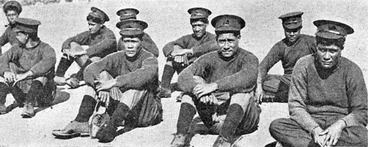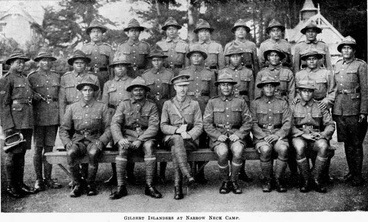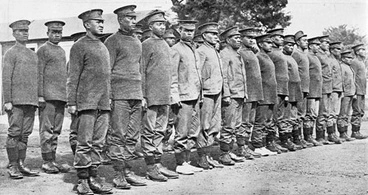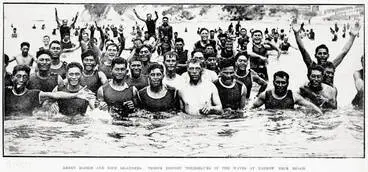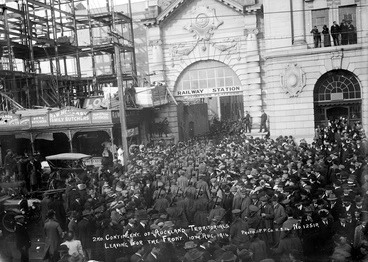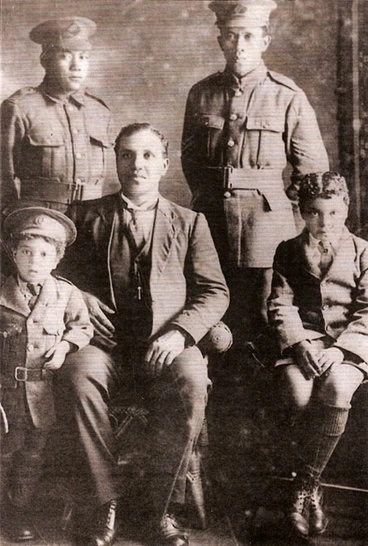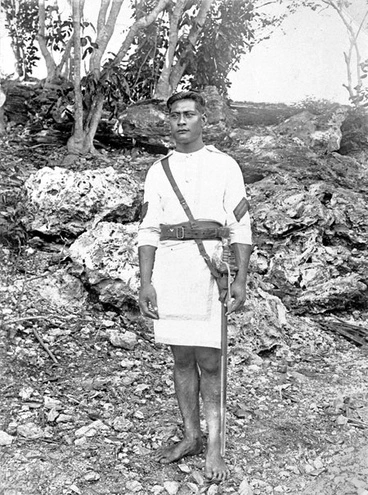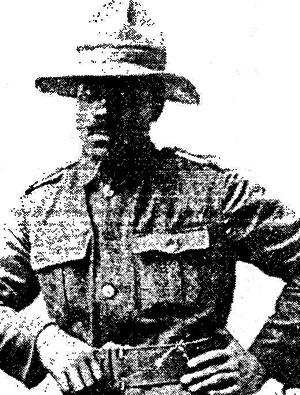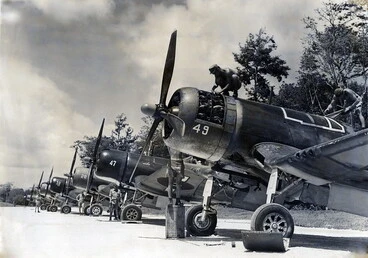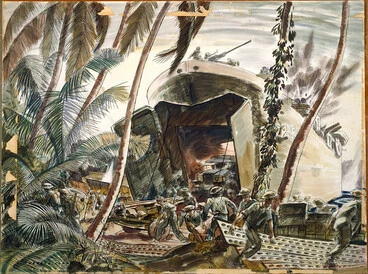War in the Pacific
A DigitalNZ Story by National Library Services to Schools
Both World Wars had a huge impact on those living in the Pacific beyond those who served in or supported the allied forces at the time.
Pacific Island recruits at Narrow Neck camp
Manatū Taonga, the Ministry for Culture and Heritage
FIRST WORLD WAR
More than 2500 Māori and Pacific Islanders served overseas with the New Zealand Expeditionary Force during the First World War. More than 700 were wounded and 336 killed.
Source: Hēnāre Kōhere, NZHistory
Gilbert Island soldiers
Manatū Taonga, the Ministry for Culture and Heritage
Rarotongan soldiers, World war One
Alexander Turnbull Library
Niuean and Cook Island soldiers on parade
Manatū Taonga, the Ministry for Culture and Heritage
PACIFIC ISLANDS CONTRIBUTION IN THE FIRST WORLD WAR
The main indigenous Pacific contribution to the New Zealand Expeditionary Force (NZEF) came from the Cook Islands and Niue, territories that had been annexed to New Zealand in 1901. The Niuean contingent and 1st Contingent of Cook Islanders provided reinforcements for the New Zealand Pioneer Battalion in Egypt and then France. The 2nd and 3rd Cooks contingents, known as the Rarotongan Company, served with the British in the Sinai and Palestine campaigns against the Ottoman Turks. All were volunteers.
Pacific Island soldiers faced many difficulties during the war. Most spoke no English and many struggled to adjust to the army diet and wearing boots. The greatest danger, though, was European diseases, especially in the cold climate of northern France.
Source: Pacific Islanders in NZEF, NZHistory
New Zealand in the Pacific - Capture of German Samoa
Manatū Taonga, the Ministry for Culture and Heritage
Pacific Islanders in NZEF - Pacific Islanders in the NZEF
Manatū Taonga, the Ministry for Culture and Heritage
Peace celebrations in the Pacific - Pacific aftermath
Manatū Taonga, the Ministry for Culture and Heritage
Postcard, 'German War Flag captured at Samoa by New Zealand Expeditionary Force'
Museum of New Zealand Te Papa Tongarewa
THE CAPTURE OF GERMAN SAMOA
When war broke out in Europe in August 1914, Britain asked New Zealand to seize German Samoa as a ‘great and urgent Imperial service’. New Zealand’s response was swift. Led by Lieutenant-Colonel Robert Logan, the 1400-strong Samoa Advance Party of the New Zealand Expeditionary Force landed at Apia on 29 August.
There was no opposition.
But had Germany placed greater importance on Samoa, or had the German East Asia Squadron intercepted the New Zealand convoy en route, the story could have been very different.
A fortnight later, on 14 September, the Scharnhorst and Gneisenau arrived off Apia and the New Zealand garrison braced itself for large-calibre gunfire. Luckily, the cruisers left once their skippers realised that Samoa was no longer in German hands. They raided Tahiti on 22 September, sinking a French gunboat and bombarding Papeete.
Source: Capture of German Samoa - Seizing German Samoa, NZHistory
GERMAN FLAG
German flag captured in Samoa.
Auckland War Memorial Museum Tāmaki Paenga Hira
Territorials leaving for Samoa
Manatū Taonga, the Ministry for Culture and Heritage
Hoisting the Union Jack, Courthouse, Apia
Alexander Turnbull Library
New Zealand troops landing in Samoa
Alexander Turnbull Library
SOME PACIFIC ISLAND WWI SOLDIERS
Leger brothers
Manatū Taonga, the Ministry for Culture and Heritage
Sergeant Kaipati
Manatū Taonga, the Ministry for Culture and Heritage
Ratu Tiale Vuiyasawa
Manatū Taonga, the Ministry for Culture and Heritage
First 300 leaving Malsi, Mono Island for New Zealand
Archives New Zealand Te Rua Mahara o te Kāwanatanga
THE SECOND WORLD WAR: WAR IN THE PACIFIC
Thousands of New Zealanders from all three of the armed forces served in the Pacific: the Navy, the Air Force, and 3 Division of the Army. It was a war that took young New Zealand men and women to exotic places, many of which they'd probably never heard of: Mono, Nissan, Guadalcanal, Bougainville, Okinawa. Sometimes working closely with the United States, New Zealanders fought the Japanese in three main areas — Singapore, the Solomon Islands and in the waters surrounding Japan. New Zealanders were also stationed in other places such as New Caledonia, operating radio and radar stations and medical facilities.
Source: War in the Pacific - The war against Japan, NZHistory
THE THIRD DIVISION
A 13,000 strong, two-brigade division, the 3rd NZ Division, under the command of Harold Barrowclough, was deployed to New Caledonia in November 1942. It later moved forward into the Solomons, where it took part in three landings. But manpower problems at home forced its withdrawal and disbandment in 1944.
AIR AND NAVAL FORCES
New Zealand also provided forces from all three armed services for the Solomons campaign, where they served under American command. The Royal New Zealand Air Force made a major contribution. In all, 20 squadrons served in the Solomons, and there were 8,000 airmen deployed there in 1945.
Source: Second World War - American counter-offensive, Te Ara - the Encyclopedia of New Zealand
World War 2 New Zealand troops, Vella Lavella, Solomon Islands
Alexander Turnbull Library
South Pacific - Fiji - Anti-tank wall, Suva Peninsula
Alexander Turnbull Library
Royal New Zealand Air Force in Pacific Islands, World War II,1939 - 1945
Archives New Zealand Te Rua Mahara o te Kāwanatanga
THE IMPACT OF THE WAR IN THE PACIFIC
The war (World War 2) in the Pacific had profound consequences for New Zealand and the region. The relationships forged with the United States during the conflict grew stronger in the years after the Second World War. In 1951 it entered a formal alliance with the United States (and Australia) that would last another 30 years.
Source: War in the Pacific - The final stages, NZHistory
Attending to a wounded World War II soldier, Pacific region
Alexander Turnbull Library
Scrap metal at Rarotonga, to be sold for the war effort
Alexander Turnbull Library
War damage on Nauru, 1940
Manatū Taonga, the Ministry for Culture and Heritage
RUSSELL CLARK
New Zealander Russell Clark was an Official War Artist in the Second World War. This sample of his paintings below depicts his experience of the war in the Pacific.
Blanche Harbour from 8th Brigade Headquarters, Stirling Island, Treasury Islands
Archives New Zealand Te Rua Mahara o te Kāwanatanga
Native guides, Mono Island
Archives New Zealand Te Rua Mahara o te Kāwanatanga
First aid near Savelse River, Mono Island
Archives New Zealand Te Rua Mahara o te Kāwanatanga
Practice landing, New Caledonia
Archives New Zealand Te Rua Mahara o te Kāwanatanga
Bringing out wounded at Mono Island
Archives New Zealand Te Rua Mahara o te Kāwanatanga
Number 1 S.U. [Service unit] Guadalcanal
Archives New Zealand Te Rua Mahara o te Kāwanatanga
FAST FACTS
- In World War Two the Cook Islands Rarotonga and Aitutaki had an active home guard to help defend the islands in case of attack.
- Only 10 days after the outbreak of World War 1 (5 August 1915) the Samoa Expeditionary Force sailed from New Zealand and captured Samoa (which was then German territory).
- During World War 1 around 500, Pacific Islanders served overseas with New Zealand forces.
- In World War 2 when American soldiers arrived in Tonga some of their instructions included;
- “Do not disturb or injure the flying foxes [bats]” and “Sunday recreation will be conducted away from the churches. Tongans will not be invited to play on Sunday.”
- On January 16, 1942, a Japanese submarine shelled Pago Pago harbour in American Samoa.
Pacific War Timeline - War in the Pacific
Manatū Taonga, the Ministry for Culture and Heritage
Landing Ships Under Fire, Treasury Island, 1943, by Russell Clark
Archives New Zealand Te Rua Mahara o te Kāwanatanga
New Zealanders in the Pacific War - War in the Pacific
Manatū Taonga, the Ministry for Culture and Heritage
Sergeant Jacob Vutha, Winner of George Medal and Purple Heart, W.W. II Pacific Theatre
Auckland War Memorial Museum Tāmaki Paenga Hira
SUPPORTING RESOURCES
Anzac day — Pacific countries reflect on their role in war.
100 Kiwi Stories of WWI — Tongan soldiers struggled in a strange land.
Cut off from the World — Tongan Islanders get their first news of the war.
Home guard on the Cook Islands — the Cook Islands Local Defence Force 1941-1945.
Invasions, naval battles and German raiders — WW1 in the Pacific.
Pa George — a biography of a Cook Islands solider in WW1.
Pacific Island littered with WWII-era debris — decades after the end of World War II, the scars of the conflict are still strikingly visible on a remote Pacific island.
The Kingdom of Tonga — Pasifika involvement in the First World War.
The smallest kingdom — Tonga Island's war effort.
Pacific Wrecks — the United States Invasion of Tonga In 1942.
Weekly Review No. 179 (1945) — official visit to the Pacific Islands during the Second World War.
Pacific soldiers — were there Pacific Islanders at Gallipoli in 1915?
WWII in Color — part 11: The Island War.
Members of the Tonga Defence Force of 2nd NZEF, during a bayonet drill in Tonga
Alexander Turnbull Library
Gun carrier platoon, Tonga Defence Force, 2nd NZEF, in Tonga
Alexander Turnbull Library
Members of the Tonga Defence Force of 2nd NZEF, learning how to operate an anti-aircraft gun, in Tonga
Alexander Turnbull Library
This story was curated and compiled by Te Puna Mātauranga o Aotearoa | National Library of New Zealand, Services to Schools staff, March 2020.
